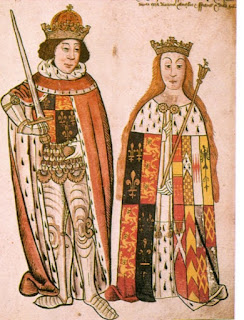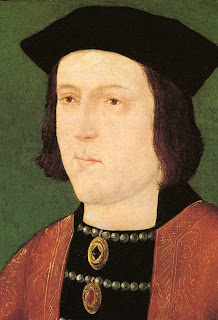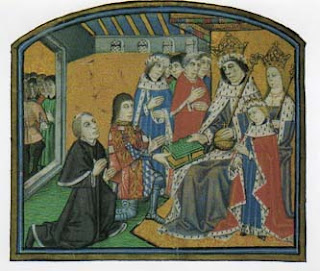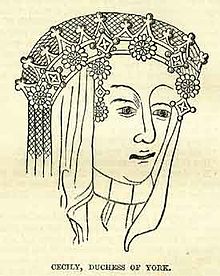Speak the name of Richard III and you will inspire a multitude of varying comments, against or in support, about this man who, for most of his life, spent his years 'in waiting' for the moment he would sit on the throne and place the crown of England upon his head. Not that I believe that Richard always had in mind he would one day be king, of course he didn't; I was speaking metaphorically. I do believe, however, that this was a man who saw an opportunity and he grabbed it. Whether or not he did so to save his own skin because he believed that he was the object of a plot to kill or oust him or whether or not he craved power or was doing it for the good of the realm, we will never know. And we will never know what was going on in the mind of this complex man at this time. Rightly or wrongly, by seizing the crown, his actions seem to have been the catalyst that brought Richard to his untimely, brutal end.
Richard, Duke of Gloucester, had been, by all accounts, a loyal and effective administrator to his brother, Edward IV, throughout his reign and his fight for the throne. He took command of the vanguard for both the battles of Tewkesbury and Barnet in which the Yorkist cause was victorious. He was also appointed Admiral and Constable of England at an early age. Richard Neville, Earl of Warwick, known as the Kingmaker, was killed at Barnet and Edward endowed Richard of Gloucester with many of the great earl's estates. Richard wed Warwick's daughter, Anne Neville, to secure these lands and later would acquire her mother's estates whilst her mother was still alive, having her declared 'deceased'. Some say the pair had always been childhood sweethearts, but there is no solid evidence for this other than they may have spent some childhood years growing up in Middleham, where Richard was schooled under the care of Warwick. Whatever the truth about their earlier relationship, he and Anne seem to have had a contented marriage. They moved residence to Middleham and Edward entrusted him as Warden of the North and the West Marches of Scotland. They had a son, Edward of Middleham, who died just before his 11th birthday. Anne was to die shortly afterwards, leaving the duke alone without a legitimate heir.
So we have built up a picture of a loyal, level-headed man, pious and honourable. Just what was his rationale for betraying his brother, by taking his sons into custody, decrying them of their legitimacy and deposing the young king, also called Edward, in favour of himself? Let us examine the events that led to that meeting at Stony Stratford when Duke Richard seized the boy who should have been crowned Edward V by the law of primogeniture.
 |
| Anne and Richard |
Edward IV's death came after a life of battle, debauchery and gluttony in April 1483. Baldwin (2013), in his book Richard III, claims that Edward's last will and later codicils showed that it was his wish that his son Edward succeed him, with Richard as his guardian. These later additions to the will have not emerged, so we don't exactly know what was in them. We do know that in the last years of his life, Edward's trust in his younger brother was evident by the offices endowed upon him in the north. It would make sense that he would have wanted Richard to have guardianship of his son and protectorship over him until he had taken up his kingship. Young Edward, on the other hand, had grown up with the Woodvilles, having been schooled from a toddler under the care of Anthony Woodville in Ludlow. Richard would most likely have been alien to him, not having been in his presence often and it would have been natural for the young king to have preferred to keep counsel with those advisors he had known all his life.
Richard's first move upon hearing of his brother's death was to ride to York and had himself and the notables there swear an oath of fealty to his brother's son. He wrote letters to the queen declaring his good intentions to her son and to the councillors of London he wrote requiring that they allow him the position wished upon him by his brother, the dead king. However the council seemed to be divided into those who would have the duke govern, as Mancini & Armstrong (1969) states and those that would have the council take control of the government with the duke as its head. It may seem that the queen and her faction were involved in discussions that would put the Woodville clan in positions of authority, greatly diminishing the weight carried by the other notables, one namely, Lord Hastings, the man who had been closest to the old King Edward (Ross, 1881).
 |
| Edward IV |
After his great friend's death, Lord Hastings may have been concerned that a Woodville takeover meant his life, or at least his welfare, was in jeopardy. Hastings acted upon those fears and sent word to Richard, warning him that the Woodvilles were attempting to sway the council's decision regarding hid protectorate. Hastings also proclaimed that if the young king's escort on his journey to London from Ludlow was not limited, he would withdraw to Calais which shows how fearful Hastings was of the Woodvilles and as he had been involved in long running disputes with Anthony and Elizabeth Woodville before, it was not surprising (Baldwin, 2013).
It was at Northampton, whilst the young king rested elsewhere, that Richard had arranged to meet with some of the boy's escort. These men were: Anthony Woodville, also known as Lord Rivers, who was the young king's uncle; Richard Grey, the king's half brother; and Woodville supporters, Sir Richard Haute and Thomas Vaughn. Richard had also arranged for the Duke of Buckingham, Henry Stafford, to meet with them there. It would seem that despite being his brother-in-law, Edward IV did not much care for Stafford but Richard was won over by his apparent loyalty and dislike of the Woodvilles. Stafford was a leading member of the old nobility, many of whom resented the 'commoner' Woodvilles' rise to power. Richard had never had any arguments, himself, with the Woodvilles, and appeared to be on good terms with Lord Rivers. Were Buckingham and Gloucester conspiring against them? It would certainly seem so. Whatever had gotten into Richard's mind at that time, he appeared to be paranoid that a Woodville plot was afoot to exclude him from the government. Was Buckingham whispering poisonous words into the king's ears? Or did Richard see an opportunity in Buckingham's warmth toward him and manipulated the duke into supporting him in the arrest of Rivers and the seizure of the young king?
 |
| Anthony Woodville presenting his book to Edward |
Richard's behaviour that night is quite revealing. The men spent the night dining and drinking convivially; accepting Richard's intentions to join the escort of the young king to London. The following morning, Rivers and the others were arrested, protesting, no doubt, as to why they were being detained. There had been no apparent hint in the two dukes demeanour that would suggest such a thing was about to happen and everyone seemed to be in agreement at dinner; why did they suddenly turn on them in the morning? Rivers must have wracked his brains to think of what he had done or said. Was this the behaviour of a level headed, intelligent, decent, pious man of royal blood? Was this 'out of character' or had Richard been harbouring or developing a deceitful nature over the years? One has to wonder what was going on here and whether or not Richard was sound of mind, or showing signs of stress and anxiety. Richard had experienced much loss, danger and trauma in his youth; witnessed the spilling of blood and the ruthlessness of men who held power. Could these past traumatic events have had an effect on his mind at such a stressful time? The loss of his brother and the vulnerability he might have felt at being excluded from the new government, may have altered a perhaps already fragile mind? The predisposing factors were definitely already there.
 |
| Elizabeth IV |
Of course this is just speculation but there maybe some scientific evidence that Richard bruxism, a stress-related grinding of teeth which shows that he may have suffered from anxiety (Gray, 2013). Being a royal person in these times was a dangerous affair. Just being alive could be stressful. It is easy to say that these men were brought up in bloodthirsty times and were used to war and battle and in Richard's case this is true, but as with today, individuals are affected in different ways after trauma and this often relies on factors such as environment, genetics and life experiences which can whittle away at one's resillience. Richard had seen plenty of violence and death and had encountered severe dangerous situations in his life, especially in his formative years. Could this have affected his judgement in such a way as to act ruthlessly and in fear of his life?
 |
| The jaw of Richard III |
What was to happen next must have seemed even more extraordinary to those contemporaries who would have witnessed the events. Richard and Buckingham moved on to Stony Stratford after this to take custody of the boy, Edward. Richard explained to his nephew, who was by all accounts a very precocious and eloquent youth, that there were men amongst his retinue who had, as Mancini & Armstrong, (1969) claims, brought about the death of his father by encouraging him in a life of debauchery. They also evidently added that these same advisors were plotting against his uncle, the Duke of Gloucester. Edward was astounded at these accusations and defended his friends with great earnestness. But his protests were to no avail. Edward was taken into their custody and his advisors, the men who had been arrested, including Rivers, were sent to Pontefract to be imprisoned.
On hearing that Richard was on his way to London with the person of the young king in his custody, and that he had arrested Rivers, Hautem, Vaughan and Grey, the Woodvilles in London dispersed and the dowager queen, Elizabeth, went into sanctuary in Westminster with her younger son Richard and her daughters. Was Richard hoping that he could secure the young king's friendship in the interim before the protectorate was to come to an end and sway him to his side? Or had was he coming to believe then, that he should make a bid for the crown? Edward V was not going to be an easy nut to crack; his defence of his advisors at Stony Stratford proved that he was more in tune with his Woodville family than his Yorkist family. In the weeks that followed, could Richard sense a hostility toward him developing in his young nephew, now deprived of his beloved uncle Anthony and his other friends? If Richard was unable to gain the boy's friendship, then what would happen to him after Edward became king?
The Woodvilles at this point seem unable to have garnered the support of the notables in London and failed to get them to side with them against Richard. This seems likely to have been due to the fact that there were many amongst the ruling classes who still harboured ill-feeling toward the family for their arrogant rise to power (Baldwin, 2013). On the 4th May, Richard rode into London with Rivers' army of 2000 men and 4 cartloads of weapons and war devices that they had been carrying with them (Kendall, 1956). Richard was said to have been keen to show them to the Mayor and aldermen of London and stress the point that Rivers et al had been planning to use violence towards him. To ease the tension, Richard called on all the men of note to swear fealty to their new king. Baldwin, (2013), suggests that the weapons were most likely quickly gathered and brought to Northampton after Richard had arrested Rivers and the others at Stony Stratford rather than before, and this seems quite credible.
With the young king settled in the Royal Apartments, Richard held discussions with the council. It seemed that he had their backing for now, most likely due to the fact that many of them disliked the Woodville's and would rather he lead them; however they refused to consider the charges against those arrested because Richard had not been invested with
vice-regal authority. During the weeks that followed, Richard made little changes in office, trying to keep the continuity of government and to keep the council on side, perhaps; to show that his intentions were honourable and in favour of the young king. He did, however, replace the chancellor, the Archbishop of York, with John Russell, Bishop of Lincoln, and Buckingham, as a reward for his assistance, was given great jurisdiction in Wales.
 |
| An artist interpretation of the princes |
Richard believed that the Woodvilles were plotting against him; at least he accused them of doing so and on the 10th of June, he wrote to Lord Neville of York to ask for the city's support against the queen dowager and those with whom she kept counsel. He claimed that they were trying to stop him from taking on his role as protector. During the weeks that had led up to the summary execution of Will Hastings, one must wonder what was going through Gloucester's mind, but whatever it was, things were about to take a more ominous turn and on the 13th June, Hastings was dragged from a council meeting and his head removed, without trial at Tower Hill. Richard, enraged, had accused him of being involved in a plot against him with the Woodvilles and Elizabeth (later known as Jane) Shore. The Archbishop of York, Lord Stanley was also arrested.
Immediately the capital was plunged into fear and alarm, for Hastings had been popular with the people. He had welcomed the establishment of Richard's protectorate and appears to have been supportive of the duke. Why did Richard believe it expedient to execute one of the men who had promised him his full support? A man who was not on good terms with the Woodvilles and had warned Richard of the Woodvilles' plans to infiltrate the governing council and limit his power. It really doesn't make sense.
 |
| Hastings is accused (c/o Richard III society) |
According to Ross (1981), Richard appears to be wading through the sea of loyalists who would be opposed to to any deposition of the young king. After Hastings death on what seem to be a trumped up charge, Rivers and the other loyalists who were arrested at Northampton were executed on the 25th of June. If Richard had at this point decided that he was going to make a bid for the crown, he knew that he would have to get rid of those who would stand in his way and hook in those that might support him. He would also have to secure both his brother's sons and so on the 16th of June, Elizabeth Woodville was willing to relinquish her youngest son Richard of York so that he could be present at the young king's coronation. This must have been a difficult decision for Elizabeth to make, to have to give up her other son to a man who had, so far, shown himself to be untrustworthy and had imprisoned her brother and older son in Pontefract. One must wonder if she had known what their fate was to be, would she have relinquished Richard of York to him so readily? Some have said that she had used the time to consider this offer from Gloucester, to whisk away the young duke to safety and replace him with a 'lookalike' who was later to return as 'Perkin Warbeck' some years later. A nice thought, however, the theory had its flaws despite the idea being a considerable one.
On the 22nd of June, which was the date scheduled for the coronation of the young king, a man named Ralph Shaw, a doctor of theology, was charged with announcing the intention of the Duke of Gloucester to make a claim for the throne. By this time, once the boys were reunited, their servants that had been in attendance on them in the royal apartments were removed from them and they were withdrawn deeper within the Tower until eventually they were not seen again. The Duke of Buckingham made a speech to the mayor and aldermen and an assembly of lords and gentry on the 24th and 25th of June, the same day that Rivers and the others lost their lives (Mancini & Armstrong, 1969).
Richard had first justified his claim to the throne by stating that his brother, Edward IV, had not been legitimate and that his mother, Cecily Neville, who was still alive at the time of his claim, had slept with a lowly French archer whilst her husband was away on duty. Evidence shows that Cecily may not have fully forgiven Richard for this disparagement of her. Cecily's insulted sensibilities aside, the implications were that Edward, being not the son of Richard, Duke of York, had not been fit to rule and so therefore his sons were also illegitimate. Richard of Gloucester put his claim forth on these grounds.
However, it would seem that perhaps Cecily's complaints may have touched a nerve and Richard may have needed another reason that would not question his mother's infidelity so the Bishop Stillington story was promulgated and Edward's boys were declared illegitimate because their father had been involved in a precontract to someone else before he married their mother, Elizabeth Woodville. But the young king's illegitimacy would not have barred him from the throne, necessarily, but, as according to Baldwin (2013), Richard would have to act fast to stop the coronation as the very act of a sacred anointing would make it difficult to challenge once the boy had been crowned before God.

With some difficulty, Buckingham managed to persuade the notables to petition Richard to take the crown and the Duke of Gloucester became King Richard III on the 26th of June. Many of us know what followed just over two years later. The princes in the Tower disappeared. Henry Tudor begins his campaign for the kingship. First Richard's son dies, followed shortly by Anne, his wife. Richard finally meets his bloody end when he and Henry face each other across Bosworth field.
So what was the role that Richard played in the death of the boys? There is no solid evidence that he harmed a hair on their little blonde heads, however, if anyone had the means, the reason, the need for them to disappear, Richard did, for they would always have been a figurehead for any further rebellions to come. Henry Tudor, who has been accused of murdering the boys to make his way clear, are often accused by those who insist that there is no evidence for Richard being guilty of their murder, without acknowledging that the same could be said for Henry. Henry was miles and miles away in France, would he have seriously been able to organise a death squad? As for Margaret Beaufort, I doubt if she would have been able to do so on her son's behalf either.
Much has been said to justify why Richard took the throne, and much has been said conversely, that Richard had no right to usurp it form his brother's son, stating that the stories of illegitimacy have no substance and that were possibly just rumours. The evidence shows that an opportunity arose and Richard took it and once the ball was rolling, he could not turn it back. That he may not have wanted the throne until he felt it was his only option to keep himself safe, may been so, but the difficulty is in not knowing what his thoughts and feelings were. If I'm honest, I do believe that he was an opportunist. I believe he felt his life was in danger and I believe that he may have been suffering from paranoia and anxiety, perhaps PTSD, but that does not excuse him from the actions he took which were ruthless, even for the day.
 |
| An artists version of Richard's crown being presented to Henry |
Richard has been painted the villain and also the hero. It seems that he was somewhere in between and that perhaps if given a chance he may have been able to redeem himself for the errors of judgement that cost so many people their lives and his own.
God Rest King Richard III
May he for ever live in peace.
I would like to thank the knowledgeable people of The Real Richard? for their kindness and being free with their knowledge,
Karen Clarke
Erika Millen
Susan Troxell
Caroline Atkinson
Any mistakes are my own.
References
Baldwin, D (2013). Richard III. Gloucestershire: Amberley.
Gray, R. 2013. The Telegraph. [Online]. [19 August 2015]. Available from: http://www.telegraph.co.uk/
Kendall, P.M (1956). Richard the Third. New York: W.W. Norton.
Mancini , D & Armstrong (1969). The Usurpation of Richard III. (2nd ed.). Oxford: Oxford.
Ross, C (1981). Richard III. London: Eyre Methuen Ltd.







































